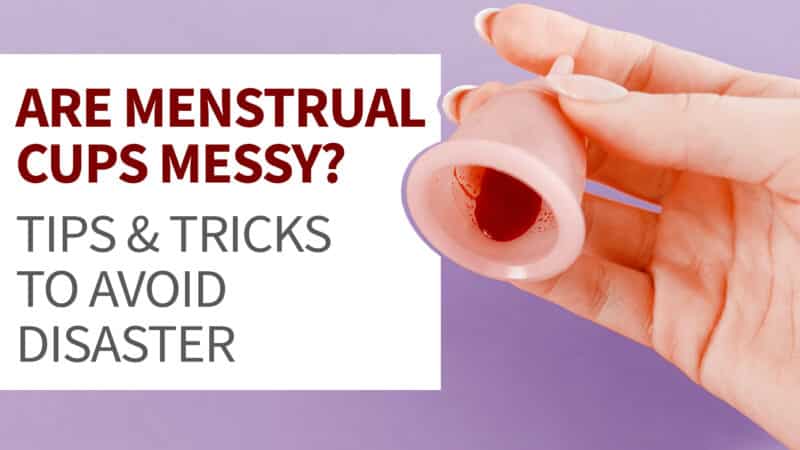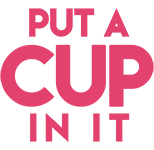
One of the biggest hesitations we hear before switching from traditional menstrual products (pads or tampons) to using a menstrual cup is the fear that it will be messy. Worry not, we’ve got you covered! So, let’s get into it.
Are Menstrual Cups Messy?
Maybe. For some there is no mess at all, and for others there may be a little. This may depend on the cup you’re using, if you have a very heavy flow (you’ll want to empty more often), and your removal technique.
Personally, I’ve found that though there is the occasional spillage of blood on my leg or the toilet seat, cups are far less messy than when I was using pads. For me, the pads would shift, especially overnight, and then I would bleed on my pajamas and sheets, rather than into the pad. Because the cup sits inside your vagina and forms a seal, I’ve had significantly less unintentional spillage and staining since I began using a cup. In over three years of using a cup, it has leaked just overnight once. With pads, it seemed to miss and make a mess at least once every few months. RIP those underwear.
Will I Get Blood from my Menstrual Cup on My Hands?
The other big concern we hear from individuals considering the switch is a fear of getting blood on their hands. We hear you, it’s clearly less than ideal, but we swear it’s much less of a big deal than we often make it out to be in our heads before we make the switch.
As someone who is actually quite uncomfortable with blood, whether my own or someone else’s. I’ve been known to go pale after seeing someone get the slightest cut on their finger, but for some reason, period blood and using a cup doesn’t phase me. Perhaps it’s because menstrual blood is natural bleeding, rather than a sign of injury. Whether or not you are uncomfortable with blood, I’ve found that I don’t get all that much blood on my hands while emptying my cup. Most of the blood is emptied into the toilet. When I was first learning, there was some missing and spillage onto my hands, but now it’s much rarer. Sure, some blood on the outside of the cup may be touching my hands and when I wash the cup before re-inserting, I will have contact with a small amount of blood, but at that point, it’s mixed with soap and water. It’s really not all that different from using a pad or tampon, which can also involve touching some blood.
4 Helpful Tips to Avoid a Mess with your Menstrual Cup
There are some useful tips though to ease the learning curve of using a cup, and to lower your chances of having a mess.
#1 Find a good position for emptying the menstrual cup.
One of the most important steps in the process of emptying your menstrual cup is figuring out what works for you. This includes what brand of cup you choose, how to fold your cup for insertion, and also how to position yourself to empty the cup. Some people find is useful to only empty in the shower, that way any spillage will be immediately washed away. Others prefer to stand with one leg on the toilet seat. For me, the best position is to sit on the toilet regularly, like when using the restroom, and to empty the cup there. This is what works for my body shape, posture, and hands. It can be worthwhile to experiment. It may not go perfectly the first time, but that way you can learn the best way to empty a cup for you. Not to mention, it’l be much easier if you find that you have to face emptying or cleaning in a public restroom.
#2 Wipe yourself after emptying your menstrual cup, before standing.
Once you’ve removed and emptied your cup in the toilet or shower you are ready to wash it before putting it back in your vagina. But freeze! Before standing or moving, wipe the base of your vagina and vulva with toilet paper. Almost every time I have gotten blood on my leg or the toilet or clothes or the floor, it was because I skipped this step and went straight to the sink to clean the cup. Yes, the cup catches most of the blood, but often, there is some left on your body. Wiping these remnants away will prevent any unintentional, and unwelcome, drippage.
#3 Check that the menstrual cup is fully open and situated correctly.
Once you’ve washed the cup, pop a squat or make your way back to the toilet to insert your cup, but before you call it done, be sure to use your index finger and check that the rim of cup is fully open all the way around. If the cup isn’t opening all the way, I’ve found it helpful to push it a little higher and gently spin the cup. That often does the job, and it will fully pop open. If you’re still unsure, pull it back down just a tad.
Sometimes, it can feel like the process of emptying and replacing my cup takes forever, but since I only empty my cup every twelve hours, in total it’s less time than when I had to change a pad or tampon every few hours. Plus, I have gotten much faster at washing and replacing my cup over time. I promise these few extra seconds to check the cup is situated right will be well worth it. If the cup isn’t open all the way or is at an angle, that is when you are most likely to have leaking, and we all want to avoid that!
#4 Give backup a try, especially when just starting with a menstrual cup or menstrual disc!
There is a bit of a learning curve when you transition to using a cup. Using panty liners, pads (cloth is a great way to send less to the landfill), or period underwear can help provide peace of mind and extra protection and comfort, especially when you need to leave the house.
These tips from my experiences of using a cup, but what are some tips you’ve found for making menstrual cups less messy?




